How to Make Paid Parking Popular in Sacramento

Paid parking can solve congestion and fund neighborhood improvements. When revenue stays local and benefits are visible, paid parking can also be politically popular. Sacramento can learn from Pasadena and San Diego: let neighborhoods see direct, tangible rewards from paid parking. If done right, it might not take long before communities across Sacramento start asking for parking meters in their neighborhoods.
How Parking Benefit Districts Work
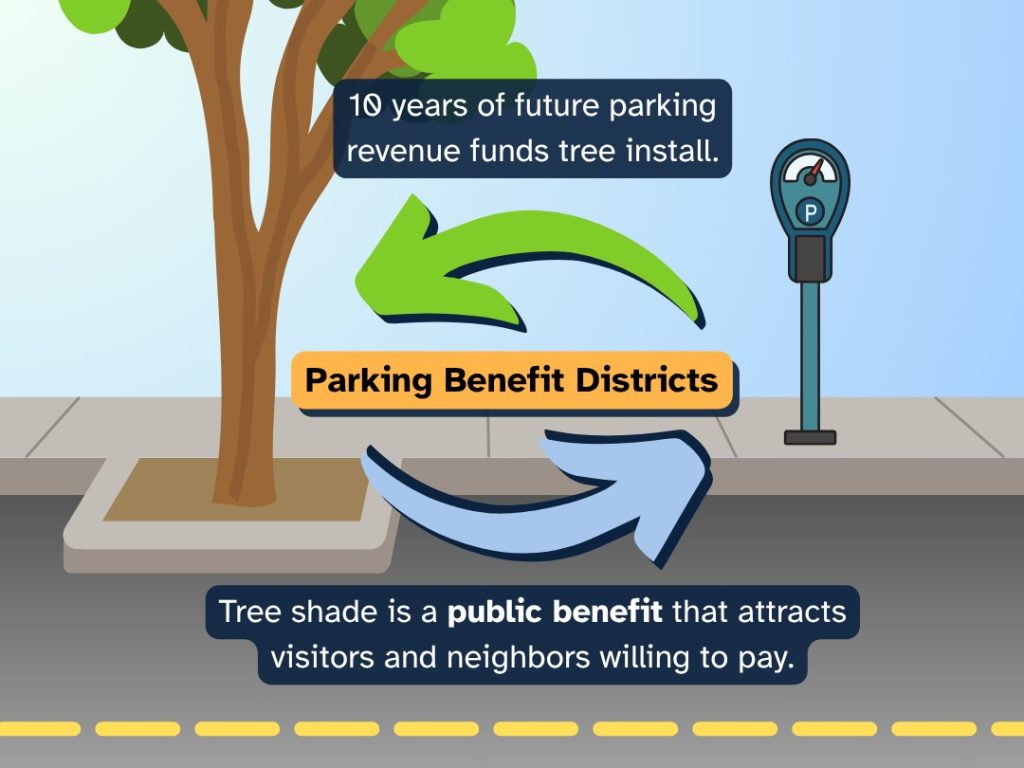
A parking benefit district (PBD) designates a neighborhood where new meters are installed (the “district”). The first 10 years of profits from those new meters fund bonds for immediate sidewalk and bus stop upgrades (the “benefit”). After 10 years, the cycle can repeat, funding more improvements using existing meters, or additional neighborhoods can be “annexed” into the PBD by installing more meters. This ensures that the revenue generated by parking meters is invested directly back into the community.
For Sacramento, trees are the most obvious choice for a public benefit, but some neighborhoods might have more pressing needs. Accessible curb ramps, handicap parking spaces, bike racks, benches, bus shelters, and bioswales are just a few more examples of public infrastructure which can be funded with parking. Public waste bins and daily cleaning services might help in neighborhoods subject to littering. Some neighborhoods even lack sidewalks (see R St section below).
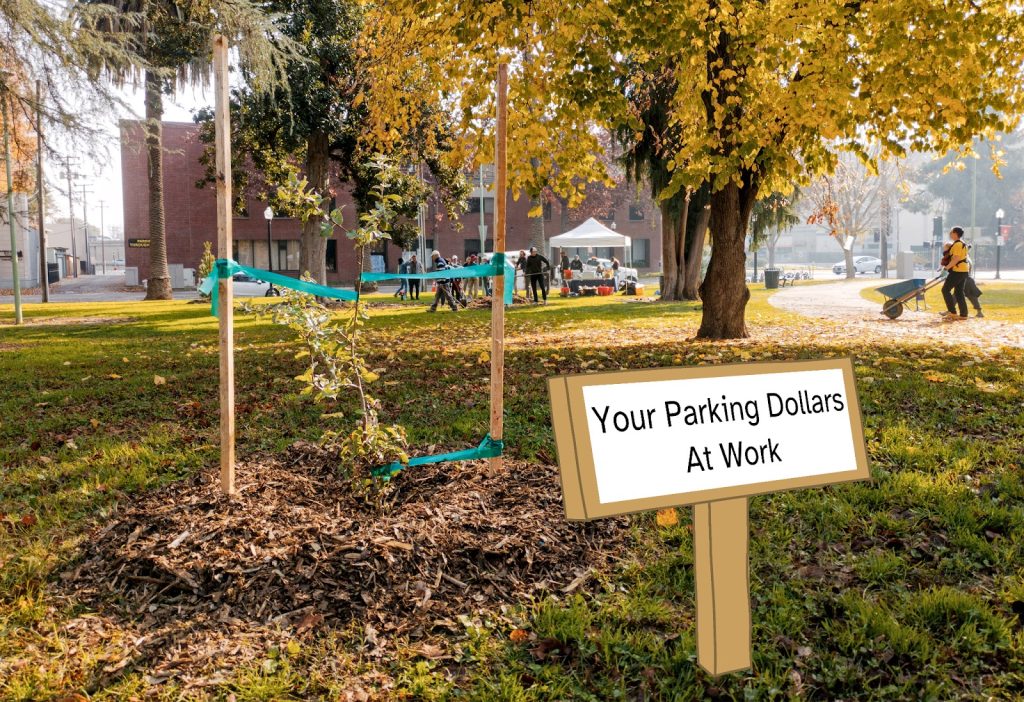
What makes PBDs innovative is their ability to win public support for paid parking. When (1) meter revenue funds visible local benefits, and (2) benefits are clearly linked to paid parking, constituents can be convinced that paid parking would actually help their neighborhood.
Why Paid Parking?
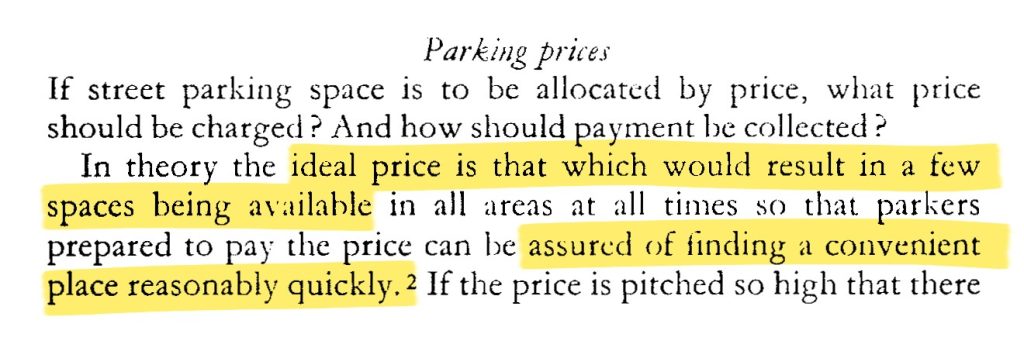
Up to 30% of downtown traffic during times of congestion consists of drivers just looking for parking (a.k.a. “cruising”). While that seems high, downtown is often not congested and most Sacramentans spend only 20 minutes or less commuting. Long ago, economists discovered that charging the right price for parking effectively prevents congestion by nudging drivers to share prime spaces and maintaining available spots on every block.
However, traffic isn’t the only problem that city centers face. By the 1990s, some innovative cities discovered how paid parking could also help revitalize their struggling business corridors.
Success Stories from California
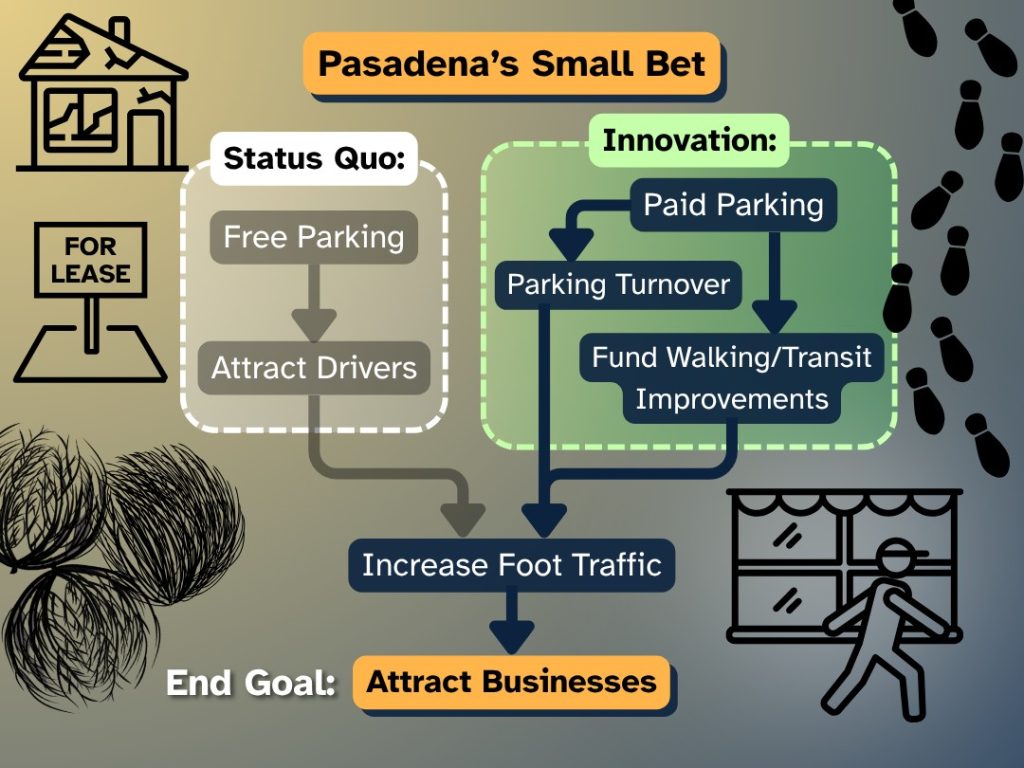
In the 1990s, Pasadena’s downtown not only struggled with congested streets, but it also had many vacant storefronts. Pasadena mitigated cruising by installing 1000+ meters across downtown and supercharged foot traffic by dedicating meter revenue to local sidewalk improvements, including new trees, benches and lighting. “[Old Pasadena’s] sales tax revenue increased rapidly after parking meters were installed in 1993, and is now higher than in the other retail districts in the city” (2003). In 1993, California’s first parking benefit district (PBD) was born in Pasadena, and it proved successful in attracting new business tenants.

Clear signage on meters reminded people that their parking money directly benefited the neighborhood. The outcome was also politically popular, which gave Pasadena’s leaders the confidence to repeat this experiment across 4 more neighborhoods, adding 750+ meters since 2008. Following Pasadena’s example, San Diego was so inspired that it approved similar parking meter programs across seven neighborhoods to fund shuttles, wider pedestrian paths and more wheelchair-accessible parking spaces. In 2023 San Diego installed 165 more meters with more planned in two more neighborhoods.
A Cautionary Tale From Sacramento

Sacramento’s recent experience shows what happens when parking revenue funds distant mega-projects instead of visible neighborhood improvements. When the Golden 1 Center was built in 2016, the City used parking revenue to help finance a single $534 million Downtown basketball arena.
To help repay arena debt, the city hiked parking rates dramatically. Garage rates were raised to cover $147 million directly, while base meter rates increased 140% between 2015 and 2025 ($1.25 → $3.00) to help offset General Fund sources. For comparison, goods, rent, and wages only increased 40%. This created public resentment among Downtown/Midtown workers, visitors, and residents who saw their daily parking costs skyrocket to subsidize a sports venue they might never use.
When 2023 & 2024 budget deficits and parking revenue shortfalls revealed that city services were being cut to help fund the arena using General Funds (money normally used for emergency services and other basic city services), public perception only deteriorated further.
Unlike Pasadena, where residents could see their parking dollars improving their own neighborhoods, Sacramento residents watched their money flow toward a single mega-project that primarily benefited team owners rather than everyday residents and local businesses. This damaged public trust and could make future parking initiatives more politically difficult, even when they do provide clear public benefits.
Example PBD: Adding Sidewalks to R Street
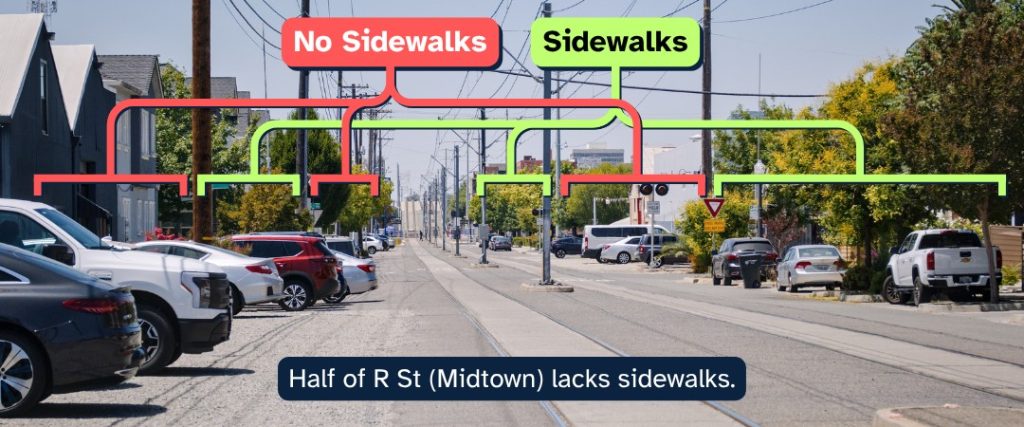
R Street in Midtown is a 5-block historic rail/industrial corridor which suffers from missing sidewalks. In 1987, two light rail stations were opened on each end of the corridor, but after almost 40 years only half the corridor gained sidewalks. Sacramento generally depends on private redevelopment to supply sidewalks, but developers prefer investing in sidewalk-rich neighborhoods, creating a chicken-and-egg problem. It could still take many more decades before sidewalks are ubiquitous in this central, transit-adjacent neighborhood.
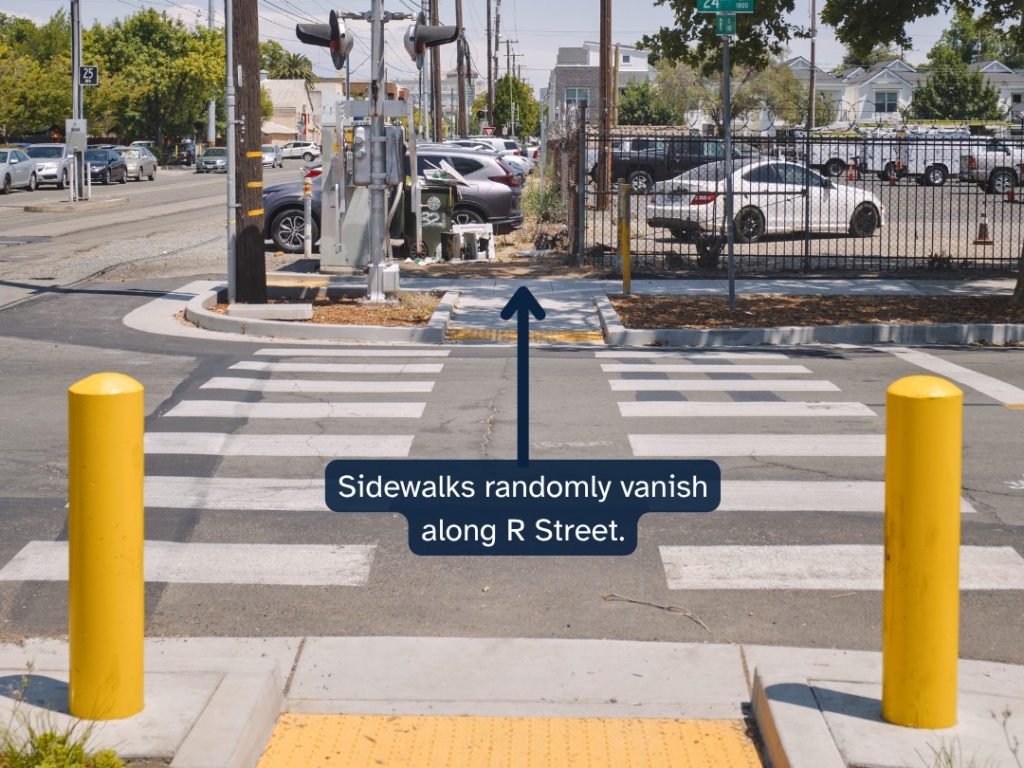
Contiguous sidewalks would be a tremendous benefit to all constituents on and near R Street. Surrounding neighborhoods would become more attractive to families who want a safe environment for their kids to roam without needing to step out into the street, and local businesses would benefit from increased foot traffic.

A PBD could pay for contiguous sidewalks quickly, bypassing the chicken-and-egg problem. Today, all parking on R Street (Midtown) is free, so new profits from meter installations can easily cover sidewalk costs.
Example PBD: Adding Street Trees to Stockton Blvd
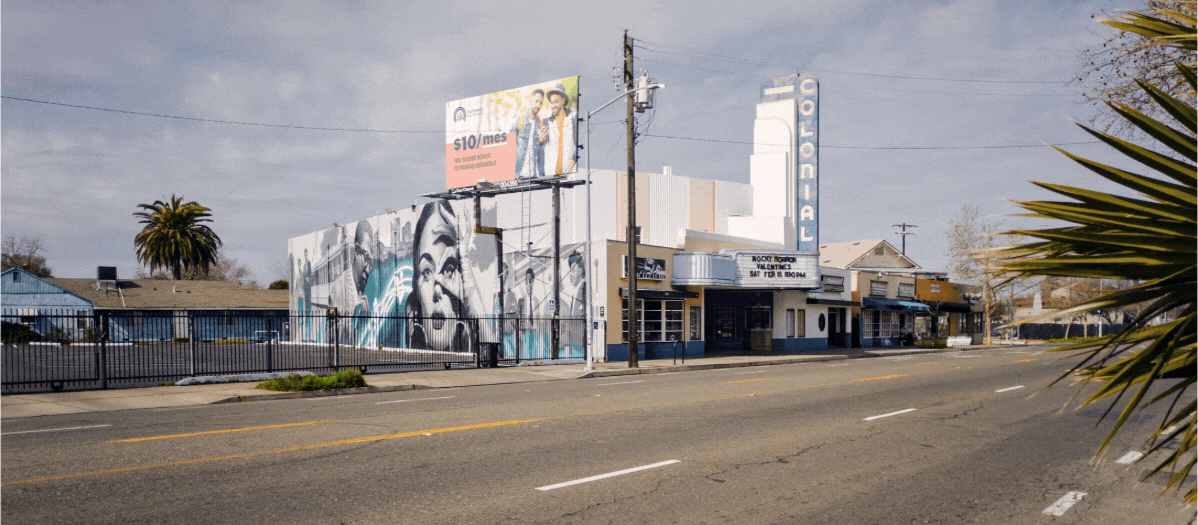
Starting in 1910, streetcars, new homes, and small businesses created a bustling commercial district with fine-grained storefronts along the 4-block stretch of Stockton Boulevard just north of Colonial Heights. This vibrant neighborhood’s decline began in the 1940s when streetcar service ended, and its fate was sealed in 1950 when Sacramento implemented its first parking mandates. The city subsequently widened Stockton Blvd, replacing street parking with more lanes of traffic. By the 1990s, Stockton Blvd had become a pass-through for suburban commuters rather than a destination for locals. Today, over half the storefronts are vacant along this 4-block section, and empty lots are a prominent feature.
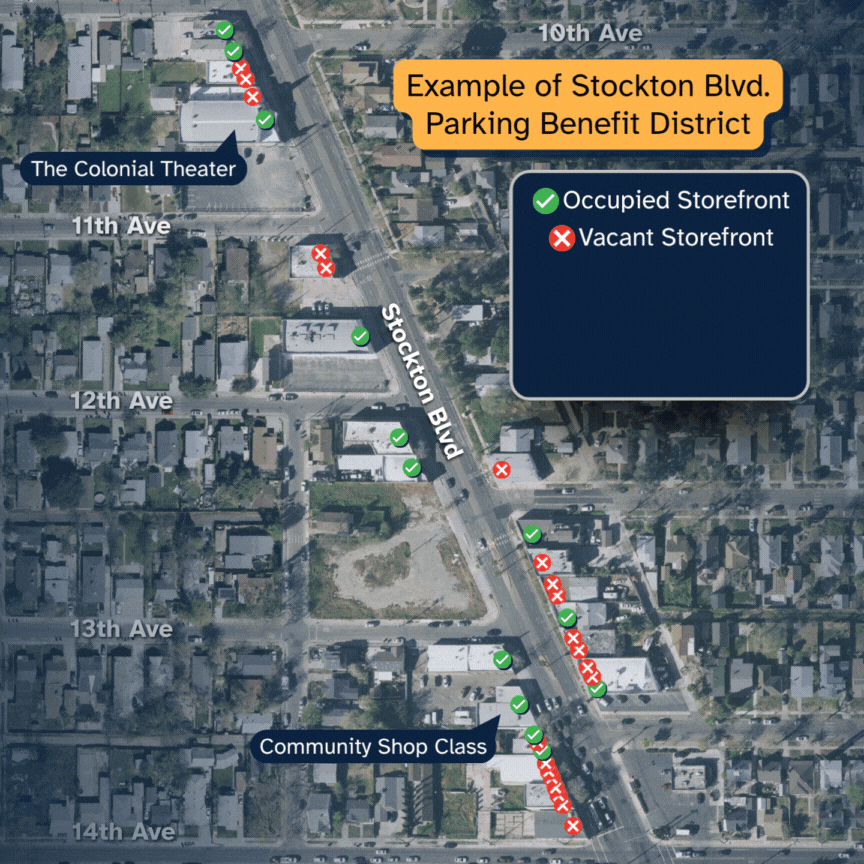
Fortunately, Stockton Blvd still has good bones and the city has committed to improvements. Stockton Blvd is a top candidate for Bus Rapid Transit (BRT), and is considered a “high priority” for planting trees. Unfortunately, good plans are often shelved due to a lack of funding—a BRT implementation will require tens of millions of dollars from sources which are drying up or already gone, and “current funding streams are insufficient to achieve the goals of the Urban Forest Plan.”
A PBD can be used to catalyze Stockton Blvd’s revitalization by quickly funding a continuous row of shade trees to turn a portion of this stroad back into a street. Trees could attract new business to fill vacant storefronts and develop empty lots (thanks to Sacramento recently eliminating parking mandates). In turn, increased foot traffic would make it easier to obtain grant funding for BRT, and this would also help Sacramento rapidly achieve tree canopy coverage goals in an area disproportionately subjected to the urban heat island effect.
Regulatory Barriers In Sacramento
Sacramento City Code §10.40.130 restricts the use of on-street parking revenue in ways that would be incompatible with a PBD. This code was last updated in 2000, but a lot has changed in the last 25 years. Most importantly, CA Proposition 26, adopted in 2010, granted cities the flexibility to spend parking revenues freely. Therefore, at minimum we should modernize §10.40.130 to allow spending meter profits from a given parking meter zone on public realm improvements within that same zone.
Summary
PBDs can instill a sense of pride and ownership among residents within the neighborhood. If the benefits are great enough to attract visitors willing to pay for parking, they will also be great enough to attract neighborhood residents alike. Improvements funded by parking meters become daily reminders of what’s possible when communities invest in themselves—safer streets, vibrant storefronts, and inviting public spaces.
With the council recently voting to double the area where parking meters are allowed, reaching well into inner-ring suburbs, now is a great time to start having a discussion about how to use those revenues. If you’re part of a local group or neighborhood/business association, let them know how a parking benefit district can help fund improvements in your neighborhood!